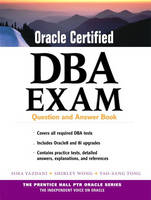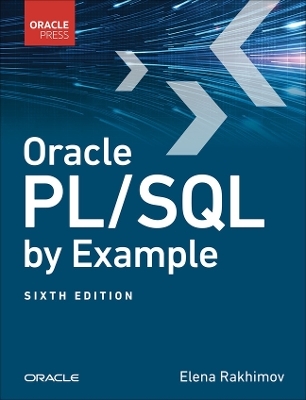
Oracle Certified DBA Exam
Prentice Hall (Verlag)
978-0-13-014271-9 (ISBN)
- Titel ist leider vergriffen;
keine Neuauflage - Artikel merken
This book is a test preparation guide for the Oracle DBA Certification Exam. The format of the book is designed to allow the student to quickly identify where their strengths and weaknesses are with respect to the exam, and then to quickly find the information they need to compensate. This information will be presented in the guide itself. In addition, the guide will contain extensive references back to Oracle's documentation.
Sima Yazdani (Javanbakht) is Senior IT Engineer at San Jose, CA-based Cisco Systems, which has one of the most advanced data warehouses in the industry. Her responsibilities include analysis and architecture of data warehouse, metadata, and Internet applications. She has worked with Oracle database technologies as a developer, DBA, and application architect since 1985. Sima also contributes to the Database Systems and Concepts certificate program at the University of California at Santa Cruz, developing the academic curriculum and teaching Oracle technology-related courses. Shirley Wong is Senior IT Project Manager at Cisco Systems, with responsibilities that include the managing and rollout of Cisco's enterprise-wide Data Warehouse decision support applications. Previously, Shirley was Vice President and Director at the Bank of America's Systems Engineering Division, where she oversaw the bank's statewide retail automation systems. She and Sima are co-authors of a DBA handbook on data warehousing. Tao-Sang Tong worked for the Oracle Corporation for over five years. At Oracle, he held several engineering positions on porting Oracle Server and Oracle Applications to different operating systems. He holds a BS degree in Computer Engineering from the University of Michigan, Ann Arbor and an MS degree in Electrical Engineering from Stanford University.
Preface.
About the Authors.
I. Introduction.
1. Introduction to Oracle Database.
Relational Database Management System. Oracle Database. Data Access with Oracle Server. Distributed Processing with Oracle Server.
Answers to the Questions in Part One.
II. UNDERSTANDING ORACLE8 ARCHITECTURE AND INSTANCE.
2. Architectural Components.
Connecting to Oracle8. Oracle8 Server. Oracle8 Instance. Oracle8 Database. Processing SQL Commands.
3. User Administration Tools.
Server Manager. SQL* Plus. SQL* Loader. Export/Import Utility. Password File Utility.
4. Managing an Oracle8 Instance.
Setting Up Authentication. Initialization of Parameter File. Starting a Database. Shutting Down a Database. Managing Sessions. Alert and Trace Files.
5. Creating a Database.
Logical Considerations. Preparing Operating System Elements. Preparing the Parameter File. Preparing the Password File. Creating the Database.
6. Data Dictionary Views.
Constructing Data Dictionary Views. Using Data Dictionary Views. Administrative Scripts. Oracle8 Supplied Packages.
Answers to the Questions in Part Two.
III. UNDERSTANDING ORACLE8 DATABASE FILES.
7. Managing Control Files.
Uses of the Control File. Multiplexing the Control File. Obtaining the Control File Information.
8. Redo Log Files.
Uses of the Redo Log File. Archiving the Log Files. Redo Buffer, Log Switches, Checkpoints, and SCN. Obtaining the Redo and Archive Log Information. Multiplexing the Log Files.
9. Tablespaces.
Types of Tablespaces. Creating Tablespaces. Managing Tablespace Allocation. Altering Tablespace Availability. Dropping Tablespaces. Obtaining Tablespace Information.
10. Managing Datafiles.
Creating Datafiles. Altering Datafile Availability. Renaming and Relocating Datafiles. Obtaining and Verifying the Datafile Information.
11. Storage Structure.
Database Storage Hierarchy. Types of Segments. Understanding the Database Block. Oracle Data Types. Block Space Utilization Parameters. Deallocating Space. Obtaining the Storage Structure Information.
Answers to the Questions in Part Three.
IV. UNDERSTANDING DATABASE OBJECTS AND THEIR INTEGRITY CONSTRAINTS.
12. Managing Rollback Segments.
Transactions and Rollback Segments. Types of Rollback Segments. Creating Rollback Segments. Altering the Rollback Segments' Availability. Dropping Rollback Segments. Obtaining the Rollback Segment Information.
13. Managing Temporary Segments.
When and How Temporary Segments Are Allocated. Types of Temporary Segments. Guidelines for Temporary Segments. Obtaining Temporary Segment Information.
14. Managing Tables.
Distinguishing Different Structures of Storing Data. Creating Tables. Guidelines for Storage Settings. Controlling the Space Used by Tables. Validating Table Structure. Partitioned Tables. Obtaining Information About Tables.
15. Managing Indexes.
Different Types of Indexes and Their Uses. Comparing B*Tree and Bitmap Indexes. Creating Indexes. Reorganizing Indexes. Dropping Indexes.
16. Managing Views, Sequences, and Synonyms.
Creating, Altering, and Dropping Views. Creating, Altering, and Dropping Sequences. Creating and Dropping Synonyms.
17. Managing Triggers and Integrity Constraints.
Types of Triggers and Integrity Constraints. Creating Triggers and Integrity Constraints. Managing Triggers and Integrity Constraints. Obtaining Constraint and Trigger Information.
Answers to the Questions in Part Four.
V. MANAGING DATABASE RESOURCES.
18. Managing Clusters and Index-Organized Tables.
Creating and Maintaining Clusters. Creating and Maintaining Index-Organized Tables (IOTs). Obtaining Information About Clusters and IOTs.
19. Managing Users.
Session and User Licensing. Create Users. Alter and Drop Existing Users. Obtaining Information About Existing Users.
20. Managing Profiles.
Creating User Profiles. Controlling the Use of Resources with Profiles. Altering and Dropping Profiles. Obtaining Information About Profiles.
21. Managing Privileges.
Identifying System and Object Privileges. Granting and Revoking Privileges. Obtaining Information About Privileges.
22. Managing Roles.
Creating and Modifying Roles. Altering the Availability of Roles. Using Predefined Roles. Obtaining Information About Roles.
Answers to the Questions in Part Five.
VI. ORACLE8 ADVANCED TOPICS AND ORACLE8I NEW FEATURES.
23. Auditing.
Guidelines for Auditing. Managing Auditing. Database and Value-Based Auditing. Obtaining Information About Auditing.
24. Using National Language Support.
NLS Features. Types of Encoding Schemes. Using Different Types of NLS Parameters. Specifying Language-Dependent Behavior. Obtaining Information About NLS Usage.
25. Oracle8i Features.
Java in the Database. Memory Management. Indexes. Index-Organized Tables. New Object-Relational Features. LOB Enhancements. Composite Partitioning. Tablespace Enhancements. Constraint Enhancements. Database Security. PKI-Based User Authentication.
Answers to the Questions in Part Six.
Index.
| Erscheint lt. Verlag | 10.1.2001 |
|---|---|
| Verlagsort | Upper Saddle River |
| Sprache | englisch |
| Gewicht | 859 g |
| Themenwelt | Informatik ► Datenbanken ► Oracle |
| ISBN-10 | 0-13-014271-9 / 0130142719 |
| ISBN-13 | 978-0-13-014271-9 / 9780130142719 |
| Zustand | Neuware |
| Informationen gemäß Produktsicherheitsverordnung (GPSR) | |
| Haben Sie eine Frage zum Produkt? |
aus dem Bereich

